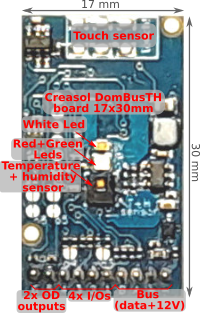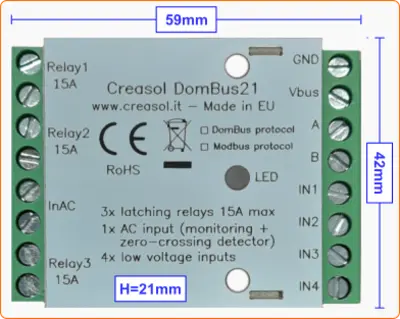
Creasol DomBusTH - Domoticz device with temperature, humidity and touch sensors, 4 inputs, 2 outputs, 3 LEDs
- On sale!
- -25%
Email: store@creasol.it - Telegram: CreasolTech - Whatsapp: +393283730010
Priority mail: fast and cheap - Express Courier: fast and safe
Before returning products, please contact us

Very compact and low power consumption module with 3 relays 15A, 1 AC input, 4 analog/digital inputs.
 Full support: most products are designed by us!
Full support: most products are designed by us!
Email: store@creasol.it - Telegram: CreasolTech - Whatsapp: +393283730010
 Orders are shipped within 1 working day
Orders are shipped within 1 working day
Priority mail: fast and cheap - Express Courier: fast and safe
 24 months warranty, easy return/refund in case of problem
24 months warranty, easy return/refund in case of problem
Before returning products, please contact us
Reliable low-power domotic module designed to enable/disable loads saving energy consumption, zeroing the standby power.
 It uses 3 latching relays, 15A 250Vac, that does not consume anything when are active, and can be used to enable loads or generators up to 3kW that are OFF for long time. Also, removing power to loads during lightning storms helps prevent damage from electrostatic discharges.
It uses 3 latching relays, 15A 250Vac, that does not consume anything when are active, and can be used to enable loads or generators up to 3kW that are OFF for long time. Also, removing power to loads during lightning storms helps prevent damage from electrostatic discharges.
It also have 1 AC input to sense 230Vac voltage (detecting power outage), that acts also as a zero-crossing detector that permits to enable relays when voltage is zero (to minimize in-rush current, in case of capacitive loads) and disable relays when current in zero (to minimize overvoltage in case of inductive loads).
4 low voltage inputs, that can be configured as analog or digital, permit to connect pushbutton switches, NTC thermal probes, alarm sensors and energy / gas / water meters with pulsed output.
The 3 latching relays can be used to enable/disable:
Default address: 0xff21
| Port# | Name | Capabilities | Default configuration | Description |
| 1 | RL1 | OUT_DIGITAL | OUT_DIGITAL | SPST 15A latching relay: coil is activated only during on/off transitions, consuming nothing when relay is ON or OFF. The INAC input should be connected to 230Vac to permit the zero-crossing detection, avoiding high in-rush current (for capacitive loads) and overvoltage (for inductive loads) |
| 2 | RL2 | OUT_DIGITAL | OUT_DIGITAL | SPST 15A latching relay: coil is activated only during on/off transitions, consuming nothing when relay is ON or OFF. The INAC input should be connected to 230Vac to permit the zero-crossing detection, avoiding high in-rush current (for capacitive loads) and overvoltage (for inductive loads) |
| 3 | RL3 | OUT_DIGITAL | OUT_DIGITAL | SPST 15A latching relay: coil is activated only during on/off transitions, consuming nothing when relay is ON or OFF. The INAC input should be connected to 230Vac to permit the zero-crossing detection, avoiding high in-rush current (for capacitive loads) and overvoltage (for inductive loads) |
| 4 | INAC | IN_AC, IN_COUNTER | IN_AC | Optoisolated input, that can be connected to a circuit breaker (to notify power outages, expecially for fridges and heat pumps), PIRs with 230V output (to monitor presence), light and appliances (to monitor when light or devices are ON). |
| 5 | IN1 | IN_DIGITAL, IN_DIGITAL_PULLDOWN, IN_ANALOG, IN_TWINBUTTON, IN_COUNTER | IN_DIGITAL | Analog or digital input, with optional 10k pullup (pcb jumper) and optional internal pulldown (activated when configured as IN_DIGITAL_PULLDOWN). Common terminal block is GND: pushbutton, switch, twinbutton (double button with 10k resistor between buttons), alarm sensor, 10k NTC thermistor, counter with pulsed output (energy meter, gas meter, water flow meter), ... should be connected to this input and to GND. |
| 6 | IN2 | IN_DIGITAL, IN_DIGITAL_PULLDOWN, IN_ANALOG, IN_TWINBUTTON, IN_COUNTER | IN_DIGITAL | Analog or digital input, with optional 10k pullup (pcb jumper) and optional internal pulldown (activated when configured as IN_DIGITAL_PULLDOWN). Common terminal block is GND: pushbutton, switch, twinbutton (double button with 10k resistor between buttons), alarm sensor, 10k NTC thermistor, counter with pulsed output (energy meter, gas meter, water flow meter), ... should be connected to this input and to GND. |
| 7 | IN3 | IN_DIGITAL, IN_DIGITAL_PULLDOWN, IN_ANALOG, IN_COUNTER | IN_DIGITAL | Analog or digital input, with internal pullup or pulldown (activated when configured as IN_DIGITAL_PULLDOWN). Common terminal block is GND: pushbutton, switch, alarm sensor, counter with pulsed output (energy meter, gas meter, water flow meter), ... should be connected to this input and to GND. |
| 8 | IN4 | IN_DIGITAL, IN_DIGITAL_PULLDOWN, IN_ANALOG, IN_COUNTER | IN_DIGITAL | Analog or digital input, with internal pullup or pulldown (activated when configured as IN_DIGITAL_PULLDOWN). Common terminal block is GND: pushbutton, switch, alarm sensor, counter with pulsed output (energy meter, gas meter, water flow meter), ... should be connected to this input and to GND. |
At power-on, the module shows on red LED the current Modbus slave address (register address=8192) in decimal format, on green LED the serial baudrate (reg. 8193), and finally on red LED the serial parity (reg. 8194).
If a value is zero, a long flash is emitted.
For example, if reg(8192)=33, reg(8193)=0, reg(8194)=0, at power the following led flashes will be shown:
3 red flashes, pause, 3 red flashes (slave address= 0x21 = 33 decimal), pause, 1 long green flash (reg(8193)=0 => baudrate=115200bps), pause, 1 long red flash (reg(8194)=0 => parity=None).
Device will be operative only when address/baudrate/parity parameters have been shown: then module will accept commands by Modbus RTU, and periodically shows output status for all ports, from 1 to max port: green flash means that port status is Off, red flash means that port is On.
Default slave address: 33 (0x21)
| Addr | Name | Values | Description |
| 0 | RL1 | 0=OFF, 1 or 65280=ON, 2-65279=ON for specified time. Logic can be inverted specifying the INVERTED option (on address 512+port) |
SPST 15A latching relay: coil is activated only during on/off transitions, consuming nothing when relay is ON or OFF. The INAC input should be connected to 230Vac to permit the zero-crossing detection, avoiding high in-rush current (for capacitive loads) and overvoltage (for inductive loads) |
| 1 | RL2 | 0=OFF, 1 or 65280=ON, 2-65279=ON for specified time. Logic can be inverted specifying the INVERTED option (on address 512+port) |
SPST 15A latching relay: coil is activated only during on/off transitions, consuming nothing when relay is ON or OFF. The INAC input should be connected to 230Vac to permit the zero-crossing detection, avoiding high in-rush current (for capacitive loads) and overvoltage (for inductive loads) |
| 2 | RL3 | 0=OFF, 1 or 65280=ON, 2-65279=ON for specified time. Logic can be inverted specifying the INVERTED option (on address 512+port) |
SPST 15A latching relay: coil is activated only during on/off transitions, consuming nothing when relay is ON or OFF. The INAC input should be connected to 230Vac to permit the zero-crossing detection, avoiding high in-rush current (for capacitive loads) and overvoltage (for inductive loads) |
| 3 | INAC | 0=OFF (floating), 1=ON (100-250V signal detected) | Optoisolated input, that can be connected to a circuit breaker (to notify power outages, expecially for fridges and heat pumps), PIRs with 230V output (to monitor presence), light and appliances (to monitor when light or devices are ON). |
| 4 | IN1 | 0=OFF, 1=ON, or 0-65535 if port is configured as analog. See below for more information. |
Analog or digital input, with optional 10k pullup (pcb jumper) and optional internal pulldown (activated when configured as IN_DIGITAL_PULLDOWN). Common terminal block is GND: pushbutton, switch, twinbutton (double button with 10k resistor between buttons), alarm sensor, 10k NTC thermistor, counter with pulsed output (energy meter, gas meter, water flow meter), ... should be connected to this input and to GND. |
| 5 | IN2 | 0=OFF, 1=ON, or 0-65535 if port is configured as analog. See below for more information. |
Analog or digital input, with optional 10k pullup (pcb jumper) and optional internal pulldown (activated when configured as IN_DIGITAL_PULLDOWN). Common terminal block is GND: pushbutton, switch, twinbutton (double button with 10k resistor between buttons), alarm sensor, 10k NTC thermistor, counter with pulsed output (energy meter, gas meter, water flow meter), ... should be connected to this input and to GND. |
| 6 | IN3 | 0=OFF, 1=ON, or 0-65535 if port is configured as analog. See below for more information. |
Analog or digital input, with internal pullup or pulldown (activated when configured as IN_DIGITAL_PULLDOWN). Common terminal block is GND: pushbutton, switch, alarm sensor, counter with pulsed output (energy meter, gas meter, water flow meter), ... should be connected to this input and to GND. |
| 7 | IN4 | 0=OFF, 1=ON, or 0-65535 if port is configured as analog. See below for more information. |
Analog or digital input, with internal pullup or pulldown (activated when configured as IN_DIGITAL_PULLDOWN). Common terminal block is GND: pushbutton, switch, alarm sensor, counter with pulsed output (energy meter, gas meter, water flow meter), ... should be connected to this input and to GND. |
| 256-273 | Port config | 1=OUT_DIGITAL, 2=OUT_RELAY_LP, ... |
Command used to configure port 1 (256), port 2 (257), ... as OUT_DIGITAL or OUT_RELAY_LP (low power consumption relay) or other value (see table below) |
| 512-529 | Port option | 0=NORMAL, 1=INVERTED (output normally ON, or input is ON when port voltage is 0V) | Set port option. If set to 1, output stays ON after boot until the port is asserted (then relays goes OFF). For inputs, setting INVERTED the port value is ON (1) when input voltage is 0V, OFF when input is left open with internal pullhigh enabled. |
| 8192 | Slave Address | 1-247 | Permits to change the slave address of the module, so it's possible to add other modules to the same bus |
| 8193 | Serial bitrate | 0=115200bps, 1=57600, 2=38400, 3=19200, 4=9600, 5=4800, 6=2400, 7=1200bps | Serial speed, default 115200 bps 8,n,1 |
| 8194 | Serial parity | 0=None, 1=Even, 2=Odd | Serial parity, default none (115200 bps 8,n,1) |
| 8198 | Revision, major | Read only | Get firmware version, major number. For example "02" means that revision is "02XX" where XX defined by parameter 8199 |
| 8199 | Revision, minor | Read only | Get firmware version, minor number. For example "h1" means that revision is "XXh1" where XX defined by parameter 8198 |
It's possible to activate one or more outputs for a certain amount of time (monostable/timer output) as indicated in the table. The parameter corresponding to the needed time can be computed using the following rules:
From 0 to 60s => 31.25ms resolution 2=62.5ms, 3=93.75ms, ... 1920=60s => value=time_in_milliseconds/31.5
From 1m to 1h with 1s resolution 1921=61s, 3540+1920=5460=1h => value=(time_in_seconds-60)+1920
From 1h to 1d with 1m resolution 5461=1h+1m, 1380+5460=6840=24h => value=(time_in_minutes-60)+5460
From 1d to 1500 days with 1h resolution 6841=25h, 6842=26h, and so on => value=(time_in_hours-24)+6840
The following tables show some Modbus commands examples.
| Slave Addr | Func. Code | Reg.Addr | Reg.Value | Frame | Description |
| 55 | 06 | 8192 | 1 | [37][06][20][00][00][01][xx][xx] | Change slave address from 54 (0x36) to 1 |
| 01 | 06 | 8193 | 4 | [01][06][20][01][00][04][D2][09] | Set serial speed to 9600bps |
| 01 | 06 | 8194 | 1 | [01][06][20][02][00][01][E2][0A] | Set even parity |
| 49 | 10 | 8192 | 1,4,1 | [31][10][20][00][00][03][06][00][01][00][04][00][01][B1][71] | With a single command, set slave address to 1, serial speed to 9600bps, even parity. Original modules address was 49 (0x31) in this example. |
| 01 | 06 | 0 | 65280 | [01][06][00][00][FF][00][C8][3A] | Activate RL1 output forever (65280=0xff00) |
| 01 | 06 | 1 | 960 | [01][06][00][01][03][C0][D8][AA] | Activate RL2 for 960/32=30s |
| 01 | 06 | 255 | 0 | [01][06][00][FF][00][00][B9][FA] | Disable all outputs (Reg.Addr=255) |
| 01 | 10 | 0 | 32,0,0,65280 | [31][10][00][00][00][04][08][00][20][00][00][00][00][FF][00][E6][5C] | Set RL1 On for 1s (32), RL2 Off, RL3 Off, RL4 On - Max 10 registers can be set in one command |
| 01 | 03 | 255 | 1 | [01][03][00][FF][00][01][B4][3A] | Read a 16bit value with ports status. For example if returned value is 0xd1 (0b11010001), output status is: RL8=On, RL7=On, RL6=Off, RL5=On, RL4=Off, RL3=Off, RL2=Off, RL1=On |
| 01 | 03 | 8198 | 2 | [01][03][20][06][00][02][2F][CA] | Read 4 bytes within module version. For example, if returned value is <30><32><68><31> (in hex format), the corresponding ASCII value is "02h1" (Firmware 02h1) |
| 01 | 0F | 0 | 8,1,0xd1 | [01][0F][00][00][00][08][01][D1][3E][C9] | Set coil status to 0xd1 (0b11010001), activating RL8, RL7, RL5, RL1 and disabling other relays |
| 01 | 01 | 0 | 8 | [01][01][00][00][00][08][3D][CC] | Read coil status. If returned value is 0xd1 (0b11010001), it means that RL8, RL7, RL5 and RL1 are On |
Modbus protocol can be tested easily using a modbus program, like mbpoll for Linux:
mbpoll -v -m rtu -0 -1 -a1 -b115200 -Pnone -r 0 /dev/ttyUSB0 32 0 64 128 0 0 0 65280
to activate RL1 for 1s, R3 for 2s, RL4 for 4s and RL8 forever.
mbpoll -v -m rtu -0 -1 -a1 -b115200 -Pnone -r 255 -c 1 /dev/ttyUSB0
to read all port states.
Heat pumps may have a standby power consumption of 5W or more: they stay On for long time, but also stay Off for very long time, so it makes sense to enable heat pump power supply only when needed.
The following diagram shows how to manage the heat pump by DomBus21 module, to get the following features on your home automation system:
The energy consumption of the DomBus21 is about 15mW even with the relays On: considering the heat pump On for 66% of the time, the energy saved is about 25kWh/year compared to a system where the heat pump is always powered and using inefficient home automation relay modules!
Also, having the heat pump disconnected may prevent damages by 230V voltage fluctuations or electrostatic discharges.
Be careful with wirings: DomBus21 handles loads with max 15A (3.5kW), which could overheat or burn out if connections are not made correctly. High power connections must be monitored with an IR thermal camera to ensure they do not overheat when delivering high power.

The following video shows a presentation of some domotic modules designed and produced in Italy by Creasol to make a reliable, easy and power-optimized home automation system.
The next video shows our Smart EVSE module that can be used to charge the electric car by using only solar power, or adding 25/50/75/100% of available power from the electrical grid.
Our industrial and home automation modules are designed to be
Modules are available in two version:

Store website - Information website
For our products we can offer FULL SUPPORT and CUSTOMIZATION: please contact us by Email or Telegram
 Complete solution to make a Smart EVSE, charging the electric vehicle using only energy from renewable source (photovoltaic, wind, ...), or adding 25-50-75-100% of available power from the grid.
Complete solution to make a Smart EVSE, charging the electric vehicle using only energy from renewable source (photovoltaic, wind, ...), or adding 25-50-75-100% of available power from the grid.
 Compact board, 32x17mm, to be installed on blank cover with a 4mm hole in the middle, to exchange air for the relative humidity sensor. It can be installed in every room to monitor temperature and humidity, check alarm sensors, control blind motor UP/DOWN, send notifications (using red and green leds) and activate white led in case of power outage.
Compact board, 32x17mm, to be installed on blank cover with a 4mm hole in the middle, to exchange air for the relative humidity sensor. It can be installed in every room to monitor temperature and humidity, check alarm sensors, control blind motor UP/DOWN, send notifications (using red and green leds) and activate white led in case of power outage.
Includes:
 Very compact, versatile and cost-effective module with 9 ports. Each port can be configured by software as:
Very compact, versatile and cost-effective module with 9 ports. Each port can be configured by software as:
 Very low power consumption module designed to enable up to 3 high power loads, up to 15A (3kW).
Very low power consumption module designed to enable up to 3 high power loads, up to 15A (3kW).
 Versatile module designed to control gate or garage door.
Versatile module designed to control gate or garage door.
 DIN rail low profile module, with 8 relays and very low power consumption:
DIN rail low profile module, with 8 relays and very low power consumption:
 Versatile module with 230V inputs and outputs, and 5 low voltage I/Os.
Versatile module with 230V inputs and outputs, and 5 low voltage I/Os.
 Module designed to control 3 lights already existing and actually controlled by 230V pushbuttons and step-by-step relays. In this way each light can be activated by existing pushbuttons, and by the domotic controller.
Module designed to control 3 lights already existing and actually controlled by 230V pushbuttons and step-by-step relays. In this way each light can be activated by existing pushbuttons, and by the domotic controller.
Each relay can toggle the existing step-relay, switching the light On/Off. The optoisolator monitors the light status. The 5 I/Os can be connected to pushbuttons to activate or deactivate one or all lights.
 DIN rail module, low profile, with 12 relays outputs and very low power consumption.
DIN rail module, low profile, with 12 relays outputs and very low power consumption.
 Module designed to be connected to alarm sensors (magnetc contact sensors, PIRs, tampers): it's able to monitor mains power supply (power outage / blackout) and also have 3 relays outputs.
Module designed to be connected to alarm sensors (magnetc contact sensors, PIRs, tampers): it's able to monitor mains power supply (power outage / blackout) and also have 3 relays outputs.
 DIN rail module designed for burglar alarm system.
DIN rail module designed for burglar alarm system.
![]() DIN rail module that control azimuth + elevation/tilt motors of a sun tracker, to maximize photovoltaic energy production during the day and seasons.
DIN rail module that control azimuth + elevation/tilt motors of a sun tracker, to maximize photovoltaic energy production during the day and seasons.
 Simple module with 2 relays, to be used with DomBus modules or other electronic boards with open-collector or open-drain outputs
Simple module with 2 relays, to be used with DomBus modules or other electronic boards with open-collector or open-drain outputs
 IoT board designed for NodeMCU v3 board using ESP8266 WiFi microcontroller
IoT board designed for NodeMCU v3 board using ESP8266 WiFi microcontroller